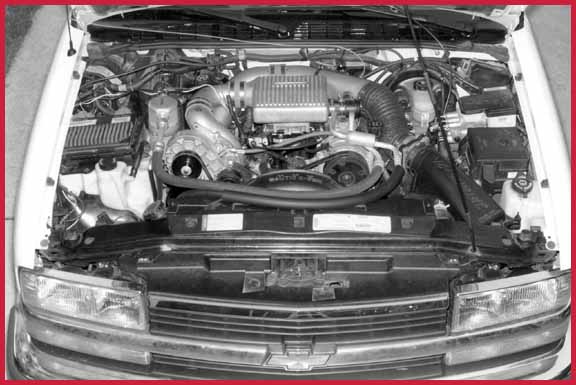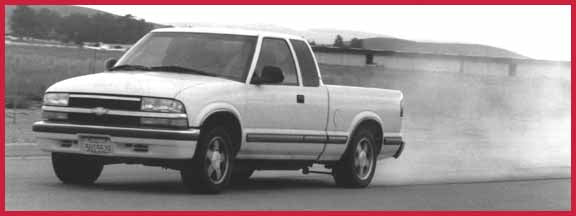S10 Swap Part 9. V8 ALTERNATIVE FOR 1996–2000 TRUCKS WITH THE 4.3 V6
 This 1998 S-10 truck has a Vortech supercharger. The performance of the supercharged V6 is similar to that of a V8 powered S-10 truck. The supercharger system adds 50 lbs to the front of the truck.
This 1998 S-10 truck has a Vortech supercharger. The performance of the supercharged V6 is similar to that of a V8 powered S-10 truck. The supercharger system adds 50 lbs to the front of the truck.
Cost of the Vortech Supercharger for 1996–2000 S-10 Trucks with the 4.3 V6 is about $3200. This may seem like a lot of money, but it is less costly than a typical V8 swap on a 1996–2000 S-10 truck, and it takes a lot less time. It took the author about 16 hours to install the kit, which comes complete with an additional fuel pump, boost retard ignition system, and auxiliary fuel management system. The author could probably do the job a second time in 8 hours.
Vortech advertises the supercharger to increase horsepower from 175 (stock) to 243. Based on the perfomance imrovements on this particular truck, the advertised claims are accurate, if not a bit conservative. The supercharger is an interesting way to improve performance, and there is potential to improve performance even more. The truck above weighs 4000 lbs with the driver. Fully warmed up, on a 50° F day, it runs 93 mph in the quarter mile and does 0-60 mph in 6.8 seconds with 3.08 gears and an automatic transmission. With 3.42 gears, it would be quicker. Using a formula (HP= weight of vehicle X (trap speed/225)(3.144 power), the horsepower is calculated to be 245 with the supercharger. Stock, the truck did 81 mph in the quarter mile‹using the above formula, the 175 horsepower rated engine is calculated at 160 (the automatic transmission probably eats up 15 horsepower). With exhaust modifications (headers and cat back system) the truck did 83 mph in the quarter mile (which calculates to 175 hp) without the supercharger.

The Vortech supercharger increases power reliably when installed per Vortech¬s instsructions. We do not, however, believe a supercharged truck should be driven under boost for long periods of time. In other words, it is great for passing and accelerating onto the freeway, and quarter-mile racing. However, if you plan on towing a heavy trailer behind your truck up a long hill, you should not keep your foot to the floor for more than a few seconds at a time because the heat build-up inside the engine could damage the stock pistons. At high altitudes (above 4000 feet), where the air is thin, it is probably ok to drive under high boost for longer periods of time.
The latest Vortech superchargers are nearly silent. The power increase from the supercharger is minimal at engine speeds below 2500 rpm. At 3000 rpm, the supercharger delivers about 3 lbs of boost and the power increase can be felt. At 5500 rpm, boost is 9 psi. By removing the snorkel on the air-cleaner assembly, and enlarging the intake opening on the air-cleaner assembly, boost improved to 12 psi at 5500 rpm. Improving the exhaust system also improved performance. To make a long story short, supercharged engines respond well to free-flowing exhaust systems and low-restriction cold-air intake sytems—a whole book could be written about superchargers and ways to improve the performance of supercharged engines.
It should be noted that the supercharged V6 is more sensitive to outside temperature than a non-supercharged engine, and when doing repeated 1/4 mile runs with no cool-down periods, the performance drops noticeably due to increased temperatures in the intake track and supercharger. Also, the supercharger requires premium fuel.
